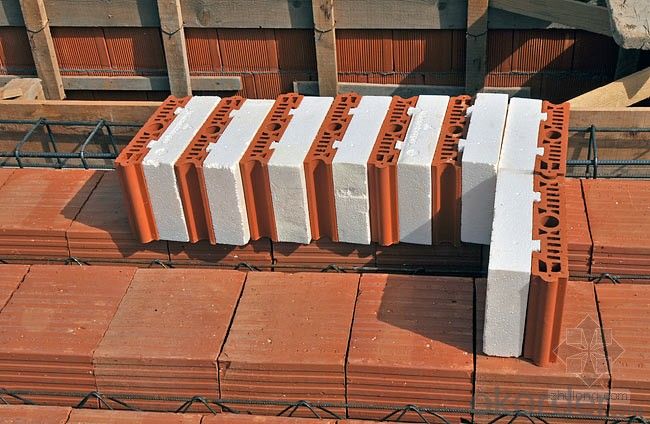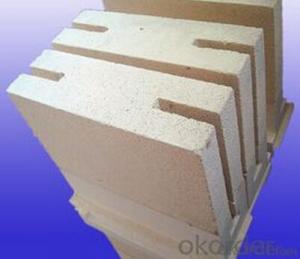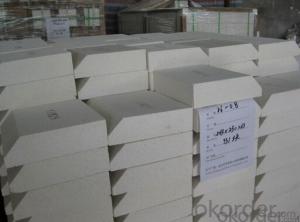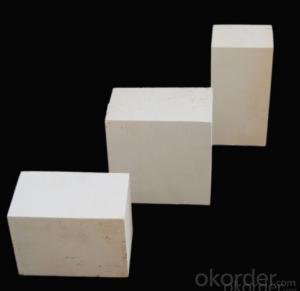Refractory Mullite Insulating Fire Brick GJM 30
- Loading Port:
- Shanghai
- Payment Terms:
- TT OR LC
- Min Order Qty:
- 5000 kg
- Supply Capability:
- 100000 kg/month
OKorder Service Pledge
OKorder Financial Service
You Might Also Like
Top insulation ceramic fiber blanket
General information of ceramic fiber blanket
Cmax ceramic fiber blanket is made of high quality kaolin clay, centrifugal high purity alumina and silica or blowing process. It's no asbestos. Double side acupuncture for easy installation provides a lot of tension or strength of the blanket.
Products are divided into standard, high pressure, HA and Hz, respectively, corresponding to the highest service temperature of 1000, 1100, 1200, and 1350
Characteristics of ceramic fiber blanket
Heat resistance
Light weight
Low thermal conductivity
Low heat storage
Thermal shock toughness
High tensile strength
Application of ceramic fiber blanket
Refractory fiber lining for petrochemical process heating furnace
Heat treatment furnace or intermittent (shuttle) kiln heat surface lining
General oven standby insulation
Heat sealing or kiln kiln car door
Electrical insulation
Ceramic fiber blanket
Common problem solutions
1. What products do you have?
We have all kinds of refractory bricks, refractory casting materials, mortar, cement, ceramic fiber products, etc..
Or you can browse our products to choose what you need.
2. How to control product quality?
With strict quality control system throughout the material selection and production process, we have the quality of refractory materials and ceramic fiber products to meet customer requirements.
From the selection of raw materials, the quality of our control to start. The quality certificate of the raw material is required, each batch of the products are to be tested in the use of the forward line. In the production process, the quality control by the workers, and then each piece of classification, and through the quality supervision and inspection.
3. Can you give me a brief introduction to the application of your product?
My company is mainly engaged in refractories in the steel, cement, glass, ceramics, petrochemical, electric power and other industries.
4. What information do you need if I need you?
In order to select the right products, we will provide us with information, such as the United States, technical data, order quantity, product application, etc..
If you have any questions, please contact us.


FAQ
1. Which products do you have?
We have all kinds of refractory brick, castable, mortar, cement, ceramic fiber products, etc.
Or you could browse our products to choose what you need.
2. How do you control the products quality?
With strict quality control system throughout the materials selection and production process, our refractory and ceramic fiber products quality is effectively controlled to meet customer requirements.
From the raw materials selecting, our quality control begin. The quality certificates of raw materials are required and each batch will be tested before using. During production, the quality control are conducted by workers and then each piece will be sorted and examined by quality supervise.
3. Can you give me a brief introduction of the application of your products?
We are mainly specializing in the refractory materials in iron and steel, cement, glass, ceramics, petrochemical, electric power Industry, etc.
4. If I need your offer, what information do you need?
In order to choose suitable products, it will be appreciated to provide us the information, such us specification, technical data, order quantity, products application etc.
If any question, please contact us freely.
- Q:Advantages and disadvantages of wall insulation system?
- The advantages of internal insulation: insulation walls, paint inside the wall, and direct people or other biological contact, in order to ensure human or biological health in insulation coating insulation at the same time, we must first ensure that the paint is non-toxic, no volatile substances.
- Q:How do insulating fire bricks affect the overall energy savings of a structure?
- Insulating fire bricks play a crucial role in enhancing the overall energy savings of a structure. These specialized bricks are designed to have low thermal conductivity, which means they are highly effective in preventing heat transfer. By using insulating fire bricks in the construction of a building, the heat loss through the walls, floors, and ceilings is significantly reduced. One of the primary ways these bricks affect energy savings is by improving the insulation of the structure. Insulating fire bricks have a high resistance to heat flow, which helps to maintain a consistent indoor temperature. This reduces the need for artificial heating or cooling, as the bricks help to keep the interior warmer during colder months and cooler during hotter months. As a result, the reliance on HVAC systems is reduced, leading to substantial energy savings. Moreover, insulating fire bricks also contribute to energy savings by minimizing thermal bridging. Thermal bridging occurs when materials with high thermal conductivity, such as metal or concrete, create pathways for heat to escape or enter the building. By using insulating fire bricks, which have low thermal conductivity, these pathways are disrupted, and heat transfer is significantly reduced. This ensures that the building's insulation remains intact and energy loss is minimized. Additionally, insulating fire bricks can improve the overall efficiency of heating appliances. By lining the interior of fireplaces, furnaces, or kilns with these bricks, the heat generated is efficiently contained, allowing for better heat distribution and reduced waste. This means that less energy is required to achieve the desired heating levels, resulting in increased energy savings. Overall, insulating fire bricks have a substantial impact on the overall energy savings of a structure. They enhance insulation, reduce thermal bridging, and improve the efficiency of heating appliances. By minimizing heat loss and optimizing heating and cooling systems, these bricks significantly reduce energy consumption, leading to long-term cost savings and a more sustainable building.
- Q:Can insulating fire bricks be used in fireplaces?
- Yes, insulating fire bricks can be used in fireplaces. Insulating fire bricks are specifically designed to withstand high temperatures and provide excellent insulation, making them suitable for use in fireplaces. They are capable of withstanding temperatures up to 3000°F (1650°C), which is well within the operating range of most fireplaces. These bricks are made from special materials that have low thermal conductivity, allowing them to retain heat and prevent it from escaping the fireplace. This insulation property helps to improve the efficiency of the fireplace by keeping the heat inside the firebox and preventing it from dissipating into the surrounding area. Additionally, insulating fire bricks are lightweight, durable, and easy to install, making them a popular choice for fireplace construction or renovation projects.
- Q:Are insulating fire bricks suitable for use in high-temperature chimneys?
- Yes, insulating fire bricks are suitable for use in high-temperature chimneys. These bricks are designed to withstand extreme heat, making them an ideal choice for insulation purposes in chimneys where temperatures can reach high levels. Insulating fire bricks provide excellent thermal resistance and insulation properties, ensuring the safety and efficiency of high-temperature chimneys.
- Q:Can insulating fire bricks be used in the construction of pottery ovens?
- Yes, insulating fire bricks can be used in the construction of pottery ovens. These bricks are designed to withstand high temperatures and provide excellent insulation, making them an ideal choice for pottery ovens where heat retention is crucial for efficient and consistent firing of pottery.
- Q:Are insulating fire bricks resistant to gas permeability?
- Yes, insulating fire bricks are resistant to gas permeability. They have low porosity and high density, which prevents the penetration of gases, making them an effective barrier against gas permeation.
- Q:Are insulating fire bricks suitable for use in thermal shock applications?
- Insulating fire bricks prove to be appropriate for thermal shock applications. Specifically designed to endure sudden temperature variations without any cracks or breaks, they possess a low thermal conductivity and a high thermal resistance, making them an optimal choice for concerns related to thermal shock. Comprised of lightweight refractory materials, these bricks often contain a significant amount of alumina or silica, which grants them exceptional thermal stability and resistance to thermal shock. Their utilization can be seen in a wide range of high-temperature scenarios, including kilns, furnaces, and fireplaces, where they face extreme temperature fluctuations. Ultimately, insulating fire bricks demonstrate their suitability for thermal shock applications by effectively enduring abrupt temperature changes and maintaining their structural integrity.
- Q:Can insulating fire bricks be used in refractory lining for steelmaking?
- Yes, insulating fire bricks can be used in refractory lining for steelmaking. Insulating fire bricks are made from lightweight ceramic materials, which have excellent thermal insulation properties. This makes them suitable for use in high-temperature applications such as steelmaking, where maintaining a consistent temperature is crucial. Insulating fire bricks can help to reduce heat loss, improve energy efficiency, and provide insulation against the extreme temperatures experienced in steelmaking processes. Additionally, these bricks are resistant to thermal shock, which is important for withstanding rapid temperature changes during steel production. Therefore, using insulating fire bricks in refractory lining for steelmaking can help to optimize the performance and efficiency of the steelmaking process.
- Q:Do insulating fire bricks expand and contract with temperature changes?
- Yes, insulating fire bricks do expand and contract with temperature changes.
- Q:Can insulating fire bricks be used in the construction of heat exchangers?
- Insulating fire bricks have the capability to be utilized in the construction of heat exchangers. These bricks are specifically designed to possess exceptional thermal insulation properties, thereby rendering them ideal for situations where the maintenance or control of high temperatures is necessary. Heat exchangers, which are devices responsible for the transfer of heat between two or more fluids, require insulation in order to prevent any loss or gain of heat during the process. The incorporation of insulating fire bricks in the construction of heat exchangers aids in the reduction of heat transfer to the surrounding environment, ultimately resulting in enhanced energy efficiency and decreased operational expenses. These bricks are capable of withstanding high temperatures, typically reaching up to 3000°F (1650°C), thus making them suitable for various heat exchanger applications, such as furnaces, boilers, and industrial processes. Moreover, insulating fire bricks possess the additional benefits of being lightweight and having low thermal conductivity. This means that they provide effective insulation while also being less bulky and more cost-effective compared to traditional refractory bricks. Consequently, they are easier to handle and install within heat exchanger systems. In conclusion, the utilization of insulating fire bricks in the construction of heat exchangers offers numerous advantages, including improved thermal insulation, enhanced energy efficiency, and reduced expenses.
1. Manufacturer Overview |
|
|---|---|
| Location | |
| Year Established | |
| Annual Output Value | |
| Main Markets | |
| Company Certifications | |
2. Manufacturer Certificates |
|
|---|---|
| a) Certification Name | |
| Range | |
| Reference | |
| Validity Period | |
3. Manufacturer Capability |
|
|---|---|
| a)Trade Capacity | |
| Nearest Port | |
| Export Percentage | |
| No.of Employees in Trade Department | |
| Language Spoken: | |
| b)Factory Information | |
| Factory Size: | |
| No. of Production Lines | |
| Contract Manufacturing | |
| Product Price Range | |
Send your message to us
Refractory Mullite Insulating Fire Brick GJM 30
- Loading Port:
- Shanghai
- Payment Terms:
- TT OR LC
- Min Order Qty:
- 5000 kg
- Supply Capability:
- 100000 kg/month
OKorder Service Pledge
OKorder Financial Service
Similar products
New products
Hot products
Related keywords




























